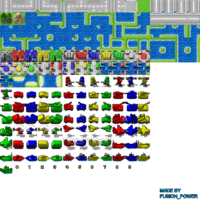fusion_power
Advanced Member
Minecraft somehow also uses OpenGL so I'm glad it runs at least fluid. ^^ To be honest, Minecraft performance got better over time. I even try some shader addons now, the Water has cool reflection effects for example. This of course really drops the FPS but the good thing is, high res Texture Packs seems to not drop the FPS on my PC. But usualy, I use standard textures and no mods at all. Game runs good on fullscreen (that means 1920x1200 in my case  ) But I still wonder how good MC could perfrom if it was written in "solid" C++ or similar. ^^""
) But I still wonder how good MC could perfrom if it was written in "solid" C++ or similar. ^^""
Whatever. I try to make a new mountain for WARS by the way, this time pre rendered in 3D with Blender so it gives nice shadings and the perspective is matching to the Buildings. But I still test it, I'm not sure if I get it good enough to make it in the Texture pack.
But I still test it, I'm not sure if I get it good enough to make it in the Texture pack.
EDIT: and here it is! Finaly with all new Mountain, done in Blender and finaly with Trees in correct angle also done in Blender. (The old Pixel Art Trees may look good enough but they don't fit anymore to the rest of the graphics imho )
Finaly with all new Mountain, done in Blender and finaly with Trees in correct angle also done in Blender. (The old Pixel Art Trees may look good enough but they don't fit anymore to the rest of the graphics imho )

Whatever. I try to make a new mountain for WARS by the way, this time pre rendered in 3D with Blender so it gives nice shadings and the perspective is matching to the Buildings.
EDIT: and here it is!

Last edited by a moderator:

